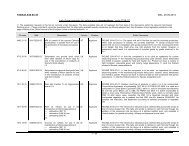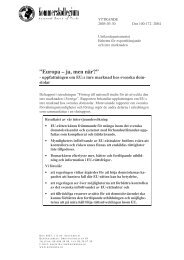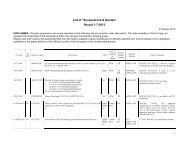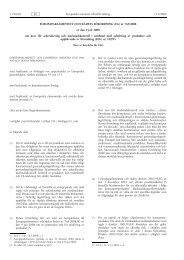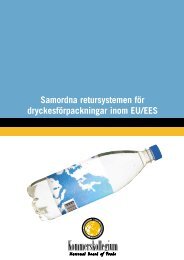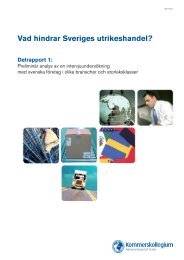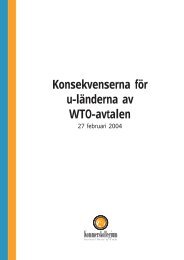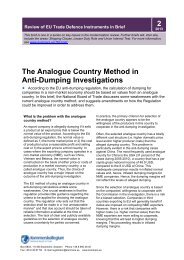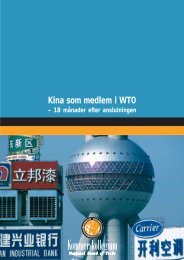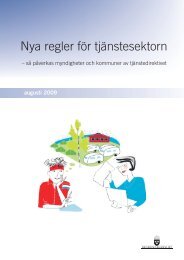Trade Facilitation - Impact and Potential Gains - Kommerskollegium
Trade Facilitation - Impact and Potential Gains - Kommerskollegium
Trade Facilitation - Impact and Potential Gains - Kommerskollegium
- No tags were found...
Create successful ePaper yourself
Turn your PDF publications into a flip-book with our unique Google optimized e-Paper software.
<strong>Trade</strong> <strong>Facilitation</strong>– <strong>Impact</strong> <strong>and</strong> <strong>Potential</strong> <strong>Gains</strong>
1 IntroductionThe importance of trade as a tool for economic development st<strong>and</strong>s uncontestedin economic theory. <strong>Trade</strong> currently represents 30 percent of world GDP <strong>and</strong> isestimated to grow to 50 percent by 2020. The importance of efficiency in trade isespecially important for smaller <strong>and</strong> more trade dependent countries such asSweden, where trade in relation to GDP is twice as important as in France <strong>and</strong>four times as important as in the US.The facilitation of trade procedures is seen by all major international organisationsas vital for economic development, not least for developing countries. <strong>Trade</strong>procedures are perceived to be a future bottleneck <strong>and</strong> there are many factors thatare fuelling the need for trade facilitation. The foremost factors are:• The large increase in international trade• The explosive IT-development, which has lead to faster, cheaper <strong>and</strong> moreefficient modes of trade <strong>and</strong> transport systems (such as Just-In-Time (JIT)management <strong>and</strong> electronic commerce)• The rapid increase in bilateral <strong>and</strong> regional free-trade agreements that oftenfeature complex Customs requirements (i.e. rules of origin)• The significant change in the nature of internationally traded goods (fromcomplete goods towards intermediate <strong>and</strong> sub-assembled products)• The increase in the comparative cost of cumbersome <strong>and</strong> anachronistic tradeprocedures, as a result of the extensive work <strong>and</strong> progress done on othertrade liberalising issues, such as tariff <strong>and</strong> quota reductions.The World Bank regards trade facilitation as an essential component for overallsuccess in economic growth <strong>and</strong> development 1 <strong>and</strong> the UN estimates the potentialsavings from trade facilitation to be of some US$490,000,000,000. 2 This sum is adeadweight loss <strong>and</strong> comes neither the government, the companies nor theindividual citizens in h<strong>and</strong>.The magnitude of the possible gains has led to the issue of trade facilitation beingincluded in the WTO framework.<strong>Trade</strong> procedures refers, in their most basic sense, to all the processes <strong>and</strong> workinvolved in fulfilling the administrative work <strong>and</strong> information processing requiredfor the movement of goods in international trade. There are of course severaltypes of formalities, procedures <strong>and</strong> paperwork that are necessary in order forgovernments <strong>and</strong> industry to conduct, monitor <strong>and</strong> control the movements ofgoods <strong>and</strong> for safeguarding every part’s legitimate interest. However, the fulfillingof an overwhelming amount of unnecessary regulations, rules, proceduralrequirements <strong>and</strong> administration constitutes a de facto cost that is beneficial tonone.The increase in security-consciousness further amplifies the need for bettermanaged<strong>and</strong> more transparent trade <strong>and</strong> customs procedures.1World Bank, 2001. ”<strong>Trade</strong> <strong>and</strong> Transport <strong>Facilitation</strong> – a Toolkit for Audit, Analysis, <strong>and</strong> RemedialAction.” Page v.2Presentation by Mike Doran at the UN/CEFACT BPAWG meeting in Geneva 3 December 2001.5
There are in a normal trade transaction potentially 27-30 different partiesinvolved, h<strong>and</strong>ling approximately 40 documents, 200 data elements (30 whichare repeated at least 30 times) of which 60-70 percent are rekeying at least once. 3Specific examples of trade facilitating measures can be the simplification ofCustoms procedures, the harmonisation of national rules, the use ofinternationally st<strong>and</strong>ardised documents <strong>and</strong> the possibility to electronically submitdocuments to authorities.<strong>Trade</strong> facilitation can be resembled to the improvement of a complex engine.Complicated <strong>and</strong> unnecessary trade procedures can be compared with the frictionin an engine; the loss of power resulting from parts not fitting well together is anoverall loss. An improvement in how the parts fit together (trade facilitation)would result in less friction/costs. This would constitute a profit that would perdefinition be equally distributed among all the involved parts (actors). <strong>Trade</strong>facilitation is a win-win game, where all countries gain.The focus of this report has been two-folded. (1) In order to illustrate the actualbenefits of trade facilitation it is necessary to show what trade facilitation is, itsgreat complexity, as well as how it works in different contexts <strong>and</strong> lastly wherefuture efforts primarily needs to be focused upon. In this context a layman’sroadmap of trade facilitation has been developed. (2) The other focus has been toaccount for the actual benefits <strong>and</strong> gains from trade facilitation, in economical<strong>and</strong> monetary terms (where possible) but also in other terms such as security,efficiency, competitiveness, qualitative <strong>and</strong> development.1.1 DefinitionThere are several definitions of trade facilitation, all relatively similar. The termgenerally refers to the simplification of procedural <strong>and</strong> administrativeimpediments to trade (such as Customs administration, st<strong>and</strong>ards <strong>and</strong> technicalregulations), as well as associated information flows required to move goodsinternationally from seller to buyer <strong>and</strong> to pass payment in the other direction.Even if there are examples of scholars who include many more issues under thebanner of trade facilitation, we will in this report use the widely accepted definitionadopted by the WTO, where trade facilitation represents:”The simplification <strong>and</strong> harmonization of international trade procedures,” withtrade procedures being ”the activities, practices <strong>and</strong> formalities involved incollecting, presenting, communicating <strong>and</strong> processing data required for themovement of goods in international trade.” 43APEC Business Advisory Council, 1996. ”1996 Report to Economic Leaders.”4WTO homepage: http://www.wto.org/english/tratop_e/tradfa_e/tradfac2_e.htm.6
2.2 Establishing Business AgreementIt is generally at this stage that an intermediary for the first time becomesinvolved. The Supplier usually, while negotiating the terms of business/contractcontracts a Credit-checking agency to verify the credit status of the Customer.There are two types of scenarios that are important to separate, a ”One-Offcontract” <strong>and</strong> a framework agreement. When comparing the costs of a transaction,the single trade transaction will appear to be much more intricate <strong>and</strong>costly than the framework transaction, due to the fact that in the latter, the termsof business <strong>and</strong> its accompanying costs have already been negotiated beforeh<strong>and</strong><strong>and</strong> are thus not as visible in the individual contract.2.3 OrderingThis phase normally begins when the Customer recognises a need for a product<strong>and</strong> places an Order under an established contact or a framework agreement. TheSupplier receives the order <strong>and</strong> responds. This response can be an acceptance,which leads to the issuing of a dispatch advise <strong>and</strong> sending of the invoice, or arejection, resulting in a change of the order until an agreement has been reached.Before the acceptance of an order, the supplier contacts an intermediary, if thishas not earlier been done, to make a Credit check.The negotiation between the Customer <strong>and</strong> the Supplier is a straightforwardprocess <strong>and</strong> trade facilitation measures have, apart from the possible interactionswith credit agencies, little marginal efficiency.2.4 ShipmentThe main focus of trade facilitation falls within the field of the actual movementof goods. The necessary preparations for enabling the goods to be delivered to theCustomer includes interactions with several new actors both governmental(Customs, licensing <strong>and</strong> certificating bodies, etc.) <strong>and</strong> various other intermediaries(insurer, custom broker, freight forwarder, carrier, chamber of commerce, etc.).Which processes <strong>and</strong> which parties that are involved, depends of course to a highdegree on the nature of the goods that are being traded. It is not uncommon thatespecially SMEs contract a custom broker who will then h<strong>and</strong>le the whole transport<strong>and</strong> Customs process.There are basically three main groups of actors involved: governmental bodies;insurers; <strong>and</strong> transport related intermediaries. The role of banks is also partlypresent, but the financing <strong>and</strong> payment aspect will be described in chapter 2.5.Figure 2 is a very simplified activity diagram of a ship-situation, showing themost basic processes involved. This scenario could be the transaction of someform of raw materials that compared with food products or livestock is verystraightforward.8
○ ○ ○ ○ ○ ○ ○ ○ ○ ○ ○ ○ ○ ○ ○ ○ ○ ○ ○ ○ ○ ○ ○ ○ ○ ○ ○ ○ ○ ○ ○○ ○ ○ ○ ○ ○ ○ ○ ○ ○ ○ ○ ○ ○ ○ ○ ○ ○ ○ ○ ○ ○ ○ ○ ○ ○ ○ ○ ○ ○ ○○ ○ ○ ○ ○ ○ ○ ○ ○ ○ ○ ○ ○ ○ ○ ○ ○ ○ ○ ○ ○ ○ ○ ○ ○ ○ ○ ○ ○ ○ ○Customer Supplier Intermediary AuthorityFigure 2StartObtain ExportLicence etc.Provide ExportLicence etc.Obtain ImportLicence etc.Provide ImportLicence etc.BookTransportConfirmTransportArrange CargoInsuranceConfirm CargoInsuranceReceiveDespatch Advise& Invoice etc.Provide CustomsImport DocumentsInitiateTransportProvideDespatch Advise& Invoice etc.Provide CustomsExport DocumentsCollect &Transport GoodsClear forExportRecord Receiptof Cleared GoodsClear forImportEnd2.4.1 InsurersThe liability of a transporter or freight forwarder is as a rule so limited that thegoods need to be extra insured. The individual trade contract/business agreementstates whether it is the Customer or Supplier who is responsible for the goodsduring transport <strong>and</strong> thus bear the cost of the insurance. Cargo insurance can betaken out on a single shipment or for several shipments within a prescribed periodof time. The insurance premium is based on the value of the goods, length oftransport, amount of re-loadings <strong>and</strong> type of transport.There is, from a trade facilitation perspective, a difference in the scope of administrativeprocedures if insurance has been taken out on a single shipment or for alonger period of time. The need for insurance is in legal terms not m<strong>and</strong>atoryeven if it in practise is a pre-requisite for conducting international business.2.4.2 Transport IntermediariesThe actual physical movement of the goods involves one or several additionalactors. Mostly a freight forwarder or a carrier is booked which delivers the goodsvia rail, road, sea or air to the designated location. Connected to these operationsare various administrative procedures <strong>and</strong> documentary requirements that arenecessary to fulfil.The most common view from the private sector, especially from SMEs, is to lookupon both insurance <strong>and</strong> transport procedures as internal business deals, notprocedures managed by governmental rules.Supervising <strong>and</strong> administrating individual contacts between private companies, bethey insurers, transporters or manufacturers, is not the direct role of tradefacilitation programmes. Yet there are several issues that lie outside the scope ofthe private market, for example administrative problems concerning thepersonnel working on the transport vessels (Visa <strong>and</strong> passport formalities).9
2.4.3 Governmental BodiesA very large part of the costs of trade administration procedures are generated inthe actual cross border situation where governmental bodies are the main actor(Customs, health authorities, export licence authorities, agriculture departments,chambers of commerce, Consulates, PSI Agencies, 6 etc). The need <strong>and</strong> potentialgains from facilitating Customs <strong>and</strong> other administrations are thus great <strong>and</strong> areperhaps the most important parts to start with <strong>and</strong> focus upon, in tradefacilitation.Customs <strong>and</strong> other authorities are faced with the apparently contradictoryobjectives of enforcing government regulations while at the same time posing theminimum obstacle to legitimate trade.The central body involved is of course the Customs, which check all thedocuments <strong>and</strong> incoming (<strong>and</strong> sometimes outgoing) goods. The port operationsare in practice so closely related to Customs controls that procedures theoreticallyconnected to port management (<strong>and</strong> thus perhaps the transport sector) will beincluded under the heading of Customs procedures.Yet the procedures for a trader, with regard to governmental dem<strong>and</strong>s, starts longbefore the actual border crossing, with finding out what specific information aparticular country dem<strong>and</strong>s. Then follows the process of collecting <strong>and</strong> providingthe right data <strong>and</strong> documentation including possible stamps <strong>and</strong> signatures <strong>and</strong>acquiring the right certificates <strong>and</strong> licenses for the goods, etc. At the actual bordercrossing all these various documents might have to be present physically togetherwith the goods <strong>and</strong> sometimes also checked manually.2.5 PaymentThe payment cycle usually starts when the Supplier has accepted the Order. TheCustomer makes the necessary arrangements to pay the Supplier on completion ofthe terms of the contract. When the Supplier requests for the payment, theCustomer instructs his Bank to initiate the payment. The payment is thenexecuted through the banking system.One widely used method is the use of a Letter of Credit (L/C), which is adocument, meant to guarantee the seller payment. However, the requirements forthe buyer to acquire a L/C might in some countries be very dem<strong>and</strong>ing <strong>and</strong>contribute to considerable costs. Governmental exchange control regulations inimporting countries, as well as slow remittance of funds by international banks(which in interests alone can amount to substantial losses) constitute furtherproblematic <strong>and</strong> expensive procedures in international trade.All stages, but one, in an International Supply Chain can in a sense be describedas business agreements between private actors – the exception being the processesconnected to governmental bodies/dem<strong>and</strong>s.The Customs <strong>and</strong> governmental procedures are however the most vital link toimprove in the trade chain <strong>and</strong> the facilitation of the governmental trade dem<strong>and</strong>sis seen, by the UN, WTO, World Bank <strong>and</strong> by the Swedish enterprises, as themost essential aspects to improve. This area has the greatest potential forsubstantial gains both for the state, the companies <strong>and</strong> ultimately for theindividual consumer.6The country of import may dem<strong>and</strong> that a Pre-Shipment Inspection (PSI) Agency inspects the goods<strong>and</strong> documents in the exporting country before the actual shipping.10
3 Main Issues in the Field of <strong>Trade</strong> <strong>Facilitation</strong>The heterogeneous nature of trade is mirrored in the multitude of variousCustoms systems <strong>and</strong> procedures, as well as in the huge number of differentregulations <strong>and</strong> documental requirements that traders are faced with. Even ifmuch has been done to ease this situation, especially in the developed countries, alot remains to be done. The main concerns can roughly be summarised under fiveheadings: 7• Excessive data <strong>and</strong> documentation requirements• Lack of transparency <strong>and</strong> use of pre-ruling systems as well as unclear <strong>and</strong>unspecified import <strong>and</strong> export requirements• Inadequate procedures <strong>and</strong> a lack of especially audit-based controls <strong>and</strong> riskassessmenttechniques• High degree of unpredictability <strong>and</strong> lack of automation <strong>and</strong> insignificant useof information-technology• Lack of modernisation of, <strong>and</strong> co-operation among, Customs <strong>and</strong> othergovernmental agencies, which thwarts efforts to deal effectively withincreased trade flows.How these obstacles exactly are shaped <strong>and</strong> to what extent they are in effect,depends of course on the specific country <strong>and</strong> type of goods studied. This makesit impossible (<strong>and</strong> fruitless) to even try to catalogue them all. It is howeverpossible, as will later be shown, 8 to point to the most common situation <strong>and</strong> someplausible exemplifying facilitating measures.There will always be some administrative costs connected to trade transactions,this is inevitable, but the goal is to keep these costs to a minimum, withoutexposing companies or Customs <strong>and</strong> other administrations to larger risks. Themain objectives are in summary:• To simplify (<strong>and</strong> eliminate where possible) formalities <strong>and</strong> procedures relatedto import, export <strong>and</strong> transit of goods• To harmonise applicable laws <strong>and</strong> regulations• To st<strong>and</strong>ardise <strong>and</strong> integrate definitions <strong>and</strong> requirements of information aswell as the use of information <strong>and</strong> communications technologies.There is, as the OECD highlights, an important distinction to make betweeneffects/costs connected to (1) specific procedures or requirements designed,directly or indirectly, to control trade <strong>and</strong> (2) problems with the operation <strong>and</strong>management of those procedures. 97As identified by the 350 participants at the WTO Symposium on <strong>Trade</strong> <strong>Facilitation</strong> in March 1998,see: ”WTO <strong>Trade</strong> <strong>Facilitation</strong> Symposium – Report by the Secretariat.”8See chapter 4.9OECD, 1999. ”Procedural Factors as Non-Tariff Barriers.”11
<strong>Trade</strong> facilitation is a comprehensive <strong>and</strong> integrated approach to reduce thecomplexity <strong>and</strong> cost of the trade transaction processes. It aims at ensuring that alltrade activities can take place in an efficient, transparent, <strong>and</strong> predictable manner,based on internationally accepted norms, st<strong>and</strong>ards <strong>and</strong> best practices. At thesame time, it seeks to optimise the effectiveness of regulatory controls to ensurethe safety <strong>and</strong> well-being of citizens <strong>and</strong> the collection of appropriate taxes <strong>and</strong>fees. 10The exact benefit of a trade facilitation measure differs from country to country,from company to company <strong>and</strong> from product to product. However, as severalinternational studies prove, the overall positive gains of trade facilitation arebeyond doubt.3.1 Previous Work <strong>and</strong> International ExperiencesAs a consequence of the methodological difficulties in making larger explicit costbenefitstudies, few have been done. The major <strong>and</strong> most widely accepted studies<strong>and</strong> estimates are presented below. It is however very problematic to crosscomparethem. They do not use the exact same definition of trade facilitation, norsimilar areas (geography wise or commodity wise) or methodological boundaries<strong>and</strong> they estimate the costs at very different periods of time. This presentationwill thus not be used to cross-compare the various previous studies, but simplyhighlight their results <strong>and</strong> show the magnitude of the possible gains resultingfrom trade facilitation.US National Committee on International <strong>Trade</strong> Documentation (US NCITD) didthe first <strong>and</strong> largest study in 1971. 11 It is a very comprehensive report <strong>and</strong> assertsfrom the factual data collected <strong>and</strong> developed in the study, that costlydocumentation is one of the major problems concerning international trade. Thereport estimated that the total documentation costs in 1971 represented 7.5percent of the value of the total US export <strong>and</strong> import shipments, approximatelyUS$ 6,500,000,000. 12 However, this estimate was later altered to the even morestaggering 10-15 percent, because the costs were assumed to exist at both ends ofa transaction. 13SWEPRO in 1985 carried out a major study on ”Data Interchange in Internationaltrade.” It estimated that, based on data from companies <strong>and</strong> statistics fromthe Swedish Central Bureau of Statistics <strong>and</strong> the Customs, the costs of Swedishtrade procedures corresponded to approximately 4 percent of the value of thegoods in both export <strong>and</strong> import situations, this constituted a procedural cost ofSEK 14,000,000,000. 1410UNECE, (2002) ”<strong>Trade</strong> <strong>Facilitation</strong> in a Global Environment.”11US National Committee on International <strong>Trade</strong> Documentation, (1971) ”Paperwork or Profit$ inInternational <strong>Trade</strong>” with the accompanying progress report two years later (1973) ”Progress reporton… Paperwork or Profit$ in International <strong>Trade</strong>.”12Approximately US$265,600,000,000 in 2001 prices.13Raven, John, (1996). ”International <strong>Trade</strong> Procedures – Characteristics <strong>and</strong> Costing.”14Approximately SEK 24,000,000,000 in 2001 prices.12
In 1987, Ernst <strong>and</strong> Whinney was contracted to do a study <strong>and</strong> business survey forthe European Commission. 15 This study was the foundation for a report byChecchini on the Customs compliance cost of the intra-EC trade, which estimatedthis cost, including both imports <strong>and</strong> exports, to be 1.5 percent of the total valueof the intra-trade between the 12 member countries. The cost would be in thevicinity of € 7,500,000,000 <strong>and</strong> if the calculated costs of business foregone wereto be added, the total cost of Customs compliance would amount toapproximately € 12,000,000,000- 23,500,000,000. 16The Asia Pacific Economic Co-operation (APEC) concludes in a study, within thethorough framework of their analysis on trade <strong>and</strong> investment liberalisation <strong>and</strong>on economic <strong>and</strong> technical co-operation, that the impact of trade facilitation inAPEC, such as streamlining of Customs procedures, exceeds that of tradeliberalisation, i.e. tariff reduction. <strong>Trade</strong> facilitation was estimated to create again of about 0.25 percent of real GDP to APEC or roughly US$ 46,000,000,000in 1997 prices. 17The Hague Consulting Group was contracted by the International Road TransportUnion (IRU) to measure the ‘invisible’ barriers to the movement of roadfreight. 18 It was estimated that the ‘avoidable’ cost to road transporters in thestudied five countries 19 was in the amount of US$ 8,000,000,000. The reportfurther estimates that the cost, if losses to producers, traders <strong>and</strong> tour operatorsas well as lost business opportunity were included, would be twice as high.There are, in addition to the above-presented studies, several estimates, whichlack a sufficient presentation of calculations <strong>and</strong> delimitation <strong>and</strong> must be treatedwith some caution. 20 In short, the studies analysed have a wide span ofestimations regarding the costs of trade procedures, ranging from 2.5-15 per centof the value of a trade transactions, It is more likely that the lower number ismore accurate in a developed country, while the higher is perhaps somewhatmore believable in a developing country. 21 A rough calculation of the lowerestimation (2.5 percent) on the value of traded goods globally would result in acost of approximately US$ 325,000,000,000 22 . This amount gives a clearindication of the magnitude of the possible gains of trade facilitation.15Titled ”Border Related Control <strong>and</strong> Administrative Formalities.”16Checchini, Paolo et al, (1988). ”The European Challenge 1992 – The Benefits of a Single Market.”17APEC, (2000). ”Cutting Through Red Tape: New Directions for APEC’s <strong>Trade</strong> <strong>Facilitation</strong> Agenda.”18Apart from costs from delays at borders, which clearly fall within the field of trade facilitation,congestions, blockaded <strong>and</strong> traffic banns were included in the calculations. The presented cost mustthus from a trade facilitating perspective be treated with some caution.19The five countries were UK; France; Italy; Czech Republic; Pol<strong>and</strong>.20The World Bank, OECD <strong>and</strong> UN/CEFACT are all independently developing studies within the field oftrade facilitation.21The presented numbers can only be seen as efforts of estimating very different situations <strong>and</strong> shouldnot be cross compared, they do however give clear indications of costs.22In year 2001 according to IMF statistics of exports <strong>and</strong> imports in world trade.13
Even if the presented calculations show the substantial costs of poorly managedtrade procedures, it is not possible to simply convert these costs per se into gains.Some of the procedures will cost more to reform than their potential facilitorygain. It is however safe to say, that even with a very modest claim of a 50 percentimprovement, the benefits from trade facilitation is probably immense.It is a bit unfortunate that most of the more in-depth studies have been done onthe conditions of developed countries, when the room for improvements <strong>and</strong>potential benefits are the highest in developing countries. With relatively minorchanges, major improvements <strong>and</strong> gains can be generated. One example of this isthe Philippine Customs, which by introducing an EDI system reduced the time forcargo held in Customs custody from 6-8 days to 4-6 hours for ”green channel”23, 24goods.A Customs modernisation programme, partly facilitated by the World Bank, inBangladesh have among many other things led to a decrease in Customs clearingtime from 3 days in 1999 to 3 hours in 2002. 25In Costa Rica, a trade facilitation programme including simplification ofprocedures, Single Window for warehouse clearing <strong>and</strong> electronic Customsdeclaration, decreased the average clearing time for goods from 6 days in 1994 to12 minutes (115 minutes for goods requiring physical inspection). 26The gains from this increase in efficiency <strong>and</strong> in its extension, in monetary gainsare very large. For more background information on previous work, the OECDhas made a report on the business benefits of trade facilitation, which is an excellentsurvey of the literature <strong>and</strong> previous work within the field of tradefacilitation. 272348 hours for consignments in need for more thorough controls.24Maniego, Buenaventura, 1999. ”The Role of Information Technology in Customs Modernisation.”25Draper, Charles, 2001. ”Reforming Customs Administration: the Unlikely Case of Bangladesh.”26See WTO, 2001. ”<strong>Trade</strong> <strong>Facilitation</strong> Experiences Paper by Costa Rica.”27OECD, 2001. ”Business Benefits of <strong>Trade</strong> facilitation – preliminary findings from literature survey,with particular focus on SMEs <strong>and</strong> developing country firms.”14
4 Developing <strong>Trade</strong> <strong>Facilitation</strong><strong>Trade</strong> facilitation is by no means a new issue in international trade. It was alreadyon the agenda in the League of Nations in 1923. The main strategy before theglobalisation of the post 1950s was primarily to establish mutual recognitionbetween different regimes <strong>and</strong> at the most to harmonise the various independentnational systems, a process that in many aspects still is very important. The workby the UN, WCO, the World Bank, numerous NGOs <strong>and</strong> most recently theWTO, have since then increased the underst<strong>and</strong>ing of international tradefacilitation, <strong>and</strong> now provides a smorgasbord of st<strong>and</strong>ards, trade <strong>and</strong> Customsprocedures. The current challenge is to establish procedures <strong>and</strong> Customs systemsbased on best practice <strong>and</strong> mutually accepted st<strong>and</strong>ards, applicable in allenvironments. However, sketching a single blueprint of a trade facilitation processthat is applicable to all countries <strong>and</strong> environments, is virtually impossible, it isnevertheless essential that all different methods, both available <strong>and</strong> underdevelopment, are mutually compatible. If effective tools <strong>and</strong> procedures areavailable, a country can after a review of its current procedures, developprogrammes fitting its particular needs, preconditions <strong>and</strong> aims. This processappears to be as inevitable as it is logical.Even if trade facilitation is a continuous process, which always needs to beadapted to a country’s specific situation, there are several measures that have aglobal acceptance <strong>and</strong> are arguably both effective <strong>and</strong> necessary. Some of thesemeasures include implementation of international st<strong>and</strong>ards <strong>and</strong> internationalagreements, which are dependent on a global usage for their success, while othersare more of a national administrative nature. One can roughly perceive a naturalchain of development: (1) measures related to st<strong>and</strong>ardisation <strong>and</strong> simplification;(2) the automation of procedures or consignment-based approach; <strong>and</strong> (3) thesystemic approach, i.e. the releasing of the physical link between documentation<strong>and</strong> consignments.In order for a trade facilitation process to be fully successful, three key elementsneeds to be present:• A strong political will <strong>and</strong> commitment• A clear strategic plan• A close co-operation with the business community.For developing countries, an additional element must be added, well-funded <strong>and</strong>long-term technical assistance based on a partnership between donor <strong>and</strong> recipient.4.1 St<strong>and</strong>ardisation <strong>and</strong> SimplificationThe evolution from antiquated trade <strong>and</strong> Customs systems, with highlybureaucratised paper-based procedures, must start by making a thorough analysis<strong>and</strong> inventory of the existing trade <strong>and</strong> Customs procedures.The aim is, to the furthest possible degree, to remove <strong>and</strong> rationalise unnecessaryrequirements; making laws <strong>and</strong> requirements transparent <strong>and</strong> easily available;decreasing the administrative layers in the process chain; <strong>and</strong> limit unnecessarychecks without jeopardising security.15
Most of the benefits from further facilitation such as automation <strong>and</strong>digitalisation of trade procedures remain empty, if Customs <strong>and</strong> other tradeprocedures have not beforeh<strong>and</strong> been simplified, st<strong>and</strong>ardised <strong>and</strong> harmonised.Just constructing an electronic version of a dysfunctional paper-based systemmakes little sense.Basic trade facilitation may be done in several ways but the following sectionconstitutes some important actions based on international tools <strong>and</strong> pastexperiences of trade facilitation projects:• St<strong>and</strong>ardisation of data <strong>and</strong> documents should be performed, preferablycombined with the implementation of st<strong>and</strong>ardised forms, in accordance withthe UN recommendation No.1: ”Layout Key for <strong>Trade</strong> Documents”(UNLK) 28• Removal of specialised documents <strong>and</strong> unnecessary procedures (for example:only one authorising official, no consular legalisation of documents)• Requirement of signatures <strong>and</strong> stamps on documents should be abolished• Aligned documents should be employed, 29 i.e. documents printed on the samesize paper with common items of information set out in the same relativeposition on each form• Government authorities should request import an export data only once <strong>and</strong>allow submission of data to a single entity as well as to furthest possibleextent use commercially orientated data, instead of specific Customs <strong>and</strong>other governmental data requirements• Laws, regulations, administrative rulings, general Customs requirements <strong>and</strong>other information regarding procedures <strong>and</strong> data requirements should bepublicised <strong>and</strong> easily available to all parties concerned. Changes should alsobe notified prior to their implementation• Presentation of supporting documentation should not be required• Penalisation of mistakes should be removed or substantially decreased• <strong>Trade</strong> transactions should be allowed outside official office hours• The level of professionalism at administrations should be raised by propertraining of staff involved• Audit based Control <strong>and</strong> Risk Management should be implemented toimprove efficiency <strong>and</strong> security in governmental administrations, especially inthe Customs situation.4.2 Automated <strong>and</strong> Digitalised SystemsThe digitalised age has opened great opportunities for trade facilitation,opportunities that in many cases are already being taken advantage of. Theverifiable gains of automation of processes to facilitate trade are substantial.These gains will however rapidly fade, if the implemented digital systems are notcompatible internationally <strong>and</strong> between different countries.28The texts of the UN recommendations can be found on http://www.unece.org/cefact.29Such as the EU single administrative document, the IATA airway bill, FIATA st<strong>and</strong>ard freight forwardersdocuments or ICC st<strong>and</strong>ard documentary credit forms.16
When making the transformation from a paper-based approach to an automated,the common experiences show that even if the exact internal systems will differ,most of the digital solutions available are however relatively compatible. Thereare several methods <strong>and</strong> systems to use, from relatively simple email basedsystems to different web solutions, <strong>and</strong> to the more sophisticated EDI solutions,where most of the transactions are being performed without direct human input.The rapid development <strong>and</strong> use of Information <strong>and</strong> Communications Technology(ICT), most importantly, the World Wide Web, have in recent years increased thepossibilities to use IT as an effective tool. The ICT development <strong>and</strong> its websolutionsconstitute a cost reduction that is very large <strong>and</strong> with a particularpromise for SMEs. Internet based <strong>and</strong> especially EDI systems enable data to beexchanged with a minimum of human intervention both faster <strong>and</strong> more efficient.Further efficient developments are the use of Single Windows, a system thatallows traders to lodge information with a single body to fulfil all import orexport related requirements. 30There still is with all automated systems, a constant need to continue thesimplification process parallel to any automation efforts, simply because thebusiness environment is ever-changing – a fact that means that so are also thetrade procedures.4.3 Systemic ApproachThe next logical step is to remove the so far fixed link between thedocumentation <strong>and</strong> data of a consignment <strong>and</strong> the physical consignment itself.The advantages of high-speed electronic data processing systems, will loose muchof its effect if the presentation of the data requirements at Customs still has to beconnected to the physical goods <strong>and</strong> its comparably slow transport speed. It is,with over 20 percent of goods today crossing borders before it is sold (estimationsindicate that this share will in 2010 have risen to over 80 percent), inevitable thata consignment-based system must be ab<strong>and</strong>oned for a more efficient systemicapproach.This means in essence that the documentation can be checked both before <strong>and</strong>after the actual border crossing of the goods. It can further enable authorisationof importers’ warehouses as Customs zones <strong>and</strong> allow periodical declaration <strong>and</strong>fast track procedures for compliant traders (as a part of risk managementprogrammes). The processes, for such a system to work, must be simple, withwell functioning risk management <strong>and</strong> a close co-operation between Customs <strong>and</strong>private sector. Sweden <strong>and</strong> the recently introduced Stairway-system is a very goodexample of how to facilitate trade in the 21st century. 31Even if this presentation of trade facilitation development is very limited <strong>and</strong> onlycovers some of the most basic measures, it nevertheless gives a fair picture of theneeded developments. For a more thorough presentation <strong>and</strong> a complete list oftrade facilitation measures, it is recommended to study the work of UN/CEFACT. 3230For more information regarding Single Window, see UN/CEFACT, 2002. ”The Single Window Concept.”31See, http://www.tullverket.se/TargetGroups/Business/frameset.htm.32In particular Recommendation 18: ”<strong>Facilitation</strong> Measures related to International <strong>Trade</strong> Procedures”<strong>and</strong> ”Compendium of <strong>Trade</strong> <strong>Facilitation</strong> Recommendations”, both available onhttp://www.unece.org/cefact.17
5 <strong>Gains</strong> from <strong>Trade</strong> <strong>Facilitation</strong>Regardless of a country’s level of simplified trade procedures, there are alwaysgains to be made from further improvements. <strong>Trade</strong> facilitation is a continuousprocess that adapts to new technologies, environments <strong>and</strong> needs of the businesscommunity <strong>and</strong> governments.In order to include the experiences, actual costs <strong>and</strong> benefits from tradefacilitation, the co-operation with companies involved in international trade hasbeen essential in this study. The presented gains <strong>and</strong> arguments have beencollected both from previous studies, internationally as well as nationally, fromthe Swedish business community <strong>and</strong> from individual companies of various sizes<strong>and</strong> types, all in order to make the picture of the gains from trade facilitation ascomplete as possible.<strong>Trade</strong> facilitation is, as have been shown, very complex <strong>and</strong> includes a multitudeof variables. This is first <strong>and</strong> foremost the case when trying to aggregate <strong>and</strong> puta monetary figure on the direct gains. Simply trying to present a prototypicaltrade transaction is a task worthy Sisyphus himself. The costs <strong>and</strong> procedures of asingle trade transactions is dependent on (1) which countries <strong>and</strong> possible transitcountries that are involved (with different legislative system, dem<strong>and</strong>s, internationalagreements <strong>and</strong> processes); (2) what type of goods; (3) means of transport(air, sea, train, road or multimodal transport); (4) the human factor i.e. the errorrate, efficiency, law abidingness <strong>and</strong> skills of the involved actors in the transaction(own employees, banks, insurers, transporters, freight forwarders, Customs <strong>and</strong>other public officials, etc); <strong>and</strong> (5) the internal procedural <strong>and</strong> administrativesystem of the companies involved in a business agreement.This situation does not mean that trade facilitation in itself is either impossible ormeaningless, just that putting an aggregate figure on the gains is very difficult. Asthe presentation in chapter 3.1, proves the benefits are massive, irrespective ofhow the studies are performed. It must however be emphasised that regardless ofthe problems of numerical measurement, trade facilitation is as necessary as it isbeneficial, something that is confirmed by all international studies on tradeprocedures <strong>and</strong> which the Swedish business community unanimously supports.Many of the gains are intertwined <strong>and</strong> it is sometimes hard to pinpoint causefrom effect, but based on the inputs from both the private <strong>and</strong> the public sector,six main aspects can be found. <strong>Gains</strong> in terms of:• Transparency <strong>and</strong> Predictability• Customer Value• Time• Security• Business Opportunity• MoneyThese aspects will be presented separately <strong>and</strong> where possible also highlight themonetary cost or gains of their effects.18
5.1 Transparency <strong>and</strong> PredictabilityThe increase in transparency <strong>and</strong> predictability is valued by the private sector asone of the most important gains from trade facilitation. Difficulties in acquiringinformation about rules <strong>and</strong> regulations, requirements to present same data atdifferent instances, combined with disparate requests <strong>and</strong> administration fordifferent countries <strong>and</strong> companies, are some of the many costs related to lack oftransparency <strong>and</strong> predictability.There is firstly a direct economical gain for all companies due to the decrease inthe internal administration. The more transparent a process is, the lower thecompliance costs, which relates to the producing, collecting, transmitting <strong>and</strong>processing of required information <strong>and</strong> documents.When the European Single Administrative Document (SAD) was introduced <strong>and</strong>implemented, over 150 different types of special documentation that previouslyneeded manual data input by companies, were removed. The gains for Europeantraders as a result is immeasurable, but are partly reflected in the comprehensiveincrease in intra-EU trade.Secondly, the easier a process is, the less likely are human or non-human errors.As international trade transactions usually requires error-free operations, even atiny error can halt entire transactions, or at least multiply the compliance cost(one Swedish enterprise had their whole shipment halted <strong>and</strong> were forced to redoall paperwork due to a miscalculation of the öre adjustment, while another isbeing fined US$900 for every error, including mistyping). The penalties connectedto compliance errors constitute on top of this a stunningly high figure.According to internal calculations of a Swedish multinational company the costof internal administration per L/C transaction is SEK 115 for intra-EU trade <strong>and</strong>SEK 3500 for trade with a third country. The difference (SEK 3385) for thiscompany would amount to SEK 5,077,500 for roughly one year.By having a transparent system with high predictability, the efficiency <strong>and</strong> profitsof the private sector greatly improves. This generates a more productive,competitive <strong>and</strong> profitable environment, benefits that according to the Swedishenterprises are immensely high. High predictability also means that the management<strong>and</strong> steering of the whole company can be greatly improved, benefits thatare important, yet hard to calculate.<strong>Trade</strong> facilitation is additionally an increasingly important factor for attractingforeign direct investment (FDIs). Cumbersome Customs <strong>and</strong> trade procedures area very effective way of deterring companies from FDIs, resulting in loss of potentialtax revenue, as well as job opportunities <strong>and</strong> prospective transfer oftechnology, all of which are wanted in most developing countries.Chilean Customs estimated that the introduction of their Electronic DataInterchange (EDI) system, which decreased the processing time, resulted in businesssavings of over US$ 1,000,000 per month, for a system cost of only US$5,000,000. 3333WTO, 2000. ”<strong>Trade</strong> <strong>Facilitation</strong>: Chile’s experience with the modernization of Customs administrationsbased on the use of information technology.”19
It is essential for developing countries that their mutual Customs <strong>and</strong> tradeprocedures become much more simple, transparent <strong>and</strong> predictable at both import<strong>and</strong> export side, since 40 percent of all manufactured goods <strong>and</strong> 30 percentof all agriculture products are traded between developing countries.A more transparent system evidently creates better possibilities for fightingcorruption, which is a plague in many developing countries. Combined with thefaster <strong>and</strong> more efficient Customs procedures these measures will greatly enhancethe revenue collections at Customs, often one of the largest sources of income inmany developing countries. 345.2 TimeDelays at borders, in harbours <strong>and</strong> other checkpoints can take days, weeks <strong>and</strong>sometimes even months. It is easy to underst<strong>and</strong> that this is a burden to trade.Delayed deliveries lead to delayed payments; penalty fees; quality diminishmentof merch<strong>and</strong>ise; storage problems; <strong>and</strong> increased risk for theft – the waiting atcheck points adds massive cost to already expensive transports. Each transactionneeds time to be processed but that time can become unnecessarily long <strong>and</strong>costly due to low productivity of officials, burdensome administration,understaffing, lack of automation but also due to more deliberate delays such aslow incentives for official, bribery, unofficial governmental regulations <strong>and</strong>premeditated for other reasons.There are numerous studies showing how facilitation of Customs procedures havereduced Customs process time from days <strong>and</strong> weeks to minutes, withoutjeopardising the crime preventing role of Customs.The decrease in border delays have for a large retail company with a turnover ofaround SEK 1,300,000,000 generated the possibility of using a central warehousefor the whole Nordic market, a restructuring that annually generates anadditional SEK 1,000,000 in profit.Lengthy processing time affects not only the opportunity cost, but also the capitalst<strong>and</strong>ing of firms, this since capital bears interest <strong>and</strong> frozen capital kills otherbusiness opportunities.The loss of interest from the time of delivery, until receipt of payment, results in areduction of the exporter’s capital st<strong>and</strong>ing <strong>and</strong> vice versa for the importer’scapital st<strong>and</strong>ing with regard to time from payment to receiving the goods.The cargo release time has, after the 5-year reform of the Peruvian Customs, beenreduced from an average of 30 days to a maximum of 24 hours for green channelcargo (one or two days for goods chosen for inspection), while at the same timequadrupling the revenue collection. 35At 12 percent interest <strong>and</strong> with the value of the Peruvian import in year 2000,this would very roughly have constituted a maximum gain to the involvedcompanies of approximately US$ 71,997,000.34According to Kubota, Keiko ”Fiscal Constraints, Collection Costs, <strong>and</strong> <strong>Trade</strong> Policies:” the averageshare of import duties to the government revenue is in low income countries 25,9 percent (comparedto 0.5 percent in the OECD countries).35For more information about the reform, see: Lane, Michael H., 2000. ”International Supply ChainManagement <strong>and</strong> Customs: Peru - a Case Study.”20
Delays in banks’ payment processing may cause considerable costs in loss ofinterest, it has been stated (without giving exact details) that the time takenbetween delivery of a good to payment can vary from 88 to 208 days. This delayrepresents, at an interest of 12 percent, between 3-7 percent of the total value ofthe goods. 36For operators whose capital reserves are thin, such as SMEs <strong>and</strong> most enterprisesof developing countries, lengthy processing constitutes a prohibitive trade barrier.Minimising the delays at border thus means a higher trade flow. A naturalconsequence of this is increased profit for companies due to higher cash-flow <strong>and</strong>increased possibilities the time for selling <strong>and</strong> buying goods. This is particularlyevident for companies exporting to bordering countries.A major international express delivery company can, as a result of the fasterCustoms procedures implemented by the Swedish Customs, utilise all their transportvehicles one extra hour a day, resulting in an hour of extra revenue. An hourof extra revenue will roughly increase the overall profits by 5-10 percent.There are, furthermore, goods that are extra sensitive to delays, such as foodstuff,livestock <strong>and</strong> high-tech products, to which delays obviously will greatly decreasethe value <strong>and</strong> sometimes destroy the goods completely, resulting in huge costs forthe individual company. It is easy to underst<strong>and</strong> what happens to tomatoes orapples when they are delayed at Customs or ports for weeks.The longer the delays are at Customs, the higher the opportunity cost of conductingtrade, reducing the possibility <strong>and</strong> benefits of cross-border trade.5.3 Business OpportunityThe cost of not being able to take advantage of business opportunities or ofbusinesses not considered, due to trade procedures, constitutes a potentiallyimportant factor. It is, as numerous studies show, extra problematic to measure,but composes a clear problem for many companies. Even if all types of companiesare hit by lost business opportunities, the burden of trade impediments, which defacto is a fixed cost, constitutes a larger share of SMEs’ costs than of largercompanies.Numerous SMEs produce innovative (<strong>and</strong> even unique) products with a soundpotential for export. Yet, often their products, partly due to costly <strong>and</strong>complicated trade procedures, rarely reach beyond the domestic markets, thuslimiting them from markets, which might multiply their turnover. There are somestudies, which show that SMEs starting with international trade have a better rateof survival. 3736WTO, 1998. ”WTO <strong>Trade</strong> <strong>Facilitation</strong> Symposium – Report by the Secretariat”, page 99-100.37According to a McKinsey Consulting report February 2001 <strong>and</strong> a Goldman Sachs report, December2000 referred to at a presentation by Ian Sayers from the International <strong>Trade</strong> Center at the workshopon trade facilitation in Geneva 2-3 April.21
<strong>Trade</strong> facilitation does not ”merely” benefit the trade or investing companiesalone, but also all transport intermediaries who would otherwise not have hadthe opportunity to transport the goods to the ”new” markets, hereby creating achain effect.Efficient administration <strong>and</strong> trade procedures are key components in attractinginvestments that in turn will create new business opportunities. In an era ofoutsourcing <strong>and</strong> JIT production techniques, the need for an efficient cargoinfrastructure, the rapid passage of inputs <strong>and</strong> finished goods through Customscontrols <strong>and</strong> streamlined transactions procedures speak for itself. A delay c<strong>and</strong>isrupt the whole production <strong>and</strong> transport chain <strong>and</strong> may result in several potentialopportunities being impossible to profit from. When asked to identify thereasons for investing in particular countries, companies frequently points toefficient trade <strong>and</strong> Customs procedures as a key component in the decision process.38Since the positive effects of a high inflow of foreign currency (via FDIs) indeveloping countries are much higher <strong>and</strong> also because SMEs in generalconstitutes the most significant share of their business sector, this means that thegains from improved market access are especially evident in developing countries.The present development <strong>and</strong> use of e-business means that regular business doesnot necessarily have to be physically present on the market. As a result, e-businesscompanies will be able to reach geographical markets, which were previously notaccessible. This means that SMEs will not have to move to more developed,larger, or more profitable areas (countries), in essence reducing the ”brain drain”by keeping innovative companies.Apart from gains of cost savings <strong>and</strong> utilising business opportunity by improvingexisting trade procedures, trade facilitation <strong>and</strong> especially electronic business isalso about the business development aspect of trade, creating new businessopportunities. The UN foresees that electronic business <strong>and</strong> the use of the InternetWorld Wide Web <strong>and</strong> associated st<strong>and</strong>ards, will bring new business opportunities<strong>and</strong> revenue streams that are linked to modern business <strong>and</strong> transport solutions,which are estimated to be worth trillions of dollars. 395.4 Customer ValueIn an international business environment that is getting ever more competitive,with shrinking margins <strong>and</strong> increased financial constraints, the need to beinnovative <strong>and</strong> to retain <strong>and</strong> generate value to the customer is essential. It is inbusiness terms estimated to be five times costlier to attract a new customer thanto retain a previous customer. With this in hindsight, creating customer value, byproviding accurate information <strong>and</strong> fast delivery at a low cost, is a vitalcompetitive edge.38WTO, 1999. ”<strong>Trade</strong> <strong>Facilitation</strong> in Relation to Development – communication from the EuropeanCommunities”, page 2.39UN/CEFACT, 2002. ”<strong>Trade</strong> <strong>Facilitation</strong> in a Global Environment”, page 10.22
Due to the growing employment of JIT management in companies, where it isessential to know the exact status of the transported goods (in order for parallelconsignments to arrive simultaneously <strong>and</strong> to know when to prepare otherprocesses <strong>and</strong> to provide customers with accurate timeframes), well facilitatedtrade procedures is essential for a foreign based company to compete on equalterms with national companies, as well as for home-based companies withfacilities located abroad.A more surprising effect of the Swedish trade facilitation work is a case, where acompany states that ”the good-will” acquired from assisting Customs as alookout for suspicious <strong>and</strong> criminal activity, gave them a competitive edge bybeing regarded as, not only a good supplier, but also a good citizen. 405.5 Security<strong>Trade</strong> facilitation is beneficial both to the business community <strong>and</strong> governments.<strong>Trade</strong>rs gain through faster delivery <strong>and</strong> reduced transaction costs. Governmentprofit in terms of enhanced revenue collection, increased economic efficiency,augmented predictability <strong>and</strong> increased opportunity to divert resources to fightcriminal activities.The awareness of the security issue in international trade has dramaticallyincreased after the tragic events of 9/11. The almost exponential increase in internationaltrade means similar increase in pressure on the Customs. <strong>Trade</strong>facilitation has in this respect a key role to play. Making Customs more efficient,by risk assessment, more efficient procedures <strong>and</strong> differing clerical work to crimeprevention, means a higher safety for countries <strong>and</strong> their citizens.A decrease in administration, leads to substantial gains for the Customsauthorities, the Federation of Swedish Enterprises estimated that the administrativecosts of trade procedures for the Swedish Customs in 1999 wereSEK 600,000,000. This cost constitutes nearly half of the whole annualgovernmental appropriation. 41By simplifying <strong>and</strong> facilitating Customs procedures, chances increase that fraud<strong>and</strong> criminal activities will be discovered. The simpler <strong>and</strong> the more transparentthe system is, the more easy it gets to detect suspicious behaviour. It furthercounteracts potential corrupt behaviour within the Customs, a cost thatgovernments rarely speak of, but too many companies have felt.The improved co-operation between economic operators <strong>and</strong> Swedish Customs,within the framework of the quality control programme <strong>and</strong> risk management,have resulted in transport companies assisting Customs officials as ”frontlinelookouts” for suspicious behaviour. A verified suspicion from a Swedish transportcompany, after receiving a dubious business proposal, lead to the detection of asmuggle attempt of cigarettes worth SEK 2,220,000.40Interview with Kjell Johansson, Director General of the Swedish Customs, in ”Ny tid för tullen”, page 2.41The governmental appropriation to the Swedish customs was in 1999 SEK 1,107,047,000.23
Facilitating Customs procedures means releasing financial resources as well asstaff, both which can be diverted from routine clerical work to the core work ofCustoms, upholding laws <strong>and</strong> preventing smuggling of drugs <strong>and</strong> weapons <strong>and</strong>other criminal activities. A transparent system further narrows the scope forcorrupt behaviour that leads to a diminishing black market sector often infectedwith costs due to crime <strong>and</strong> loss of tax revenue.5.6 MoneyA recent study carried out by the Swedish Customs on the costs of Customsprocedures, found that the total cost of Swedish Customs procedures for theSwedish companies in 1999 amounted to SEK 2,500,000,000, of these costsapproximately 60 percent were related to export procedures <strong>and</strong> 40 percent toimport procedures. 42 Add to this the estimated internal administration costs forthe Swedish Customs authorities of SEK 600,000,000 43 for a rough estimationof the total cost <strong>and</strong> possible gain of only the Customs procedures to beSEK 3,100,000,000. 44Even if this figure might seem high, it must be mentioned that Swedish Customs israted among the top three in the world 45 <strong>and</strong> these costs will in many othercountries be likely to be several times higher. Customs procedures are furthermerely one part of the governmental procedures, <strong>and</strong> the governmental bodies arejust one aspect in the international trade chain. This leads to the strongassumption that this rather low Customs compliance cost is only a fraction of thereal costs of poorly managed trade procedures.In a very unlikely scenario where this cost could in equal shares be directlytransferred to the citizens of Sweden, each person would bear a burden of a mereSEK 344 a year. This low figure is however very misleading, since this onlyconstitutes the cost of the direct Customs related paperwork in Sweden <strong>and</strong> doesnot take into account the losses from chain effects or all the other actors <strong>and</strong>areas that have been put forward in the previous chapters. It further only focuseson an internal Swedish perspective, which ignores the costs that the companiesmust bear due to the heavy <strong>and</strong> cumbersome procedures in all other countries.These costs hit the Swedish consumer (<strong>and</strong> other consumers) by higher prices ofall goods bought. If all these aspects could be included, the presented figurewould be multiplied numerous times.The fact that a unanimous business community continues to heavily stress thenecessity of facilitating all parts of trade is a crystal clear indication of the hiddengains of trade facilitation. In the discussions with Swedish companies regardingthe trade facilitation of the Swedish Customs, particularly the Stairway concept, itwas repeatedly stated that the gains from the system far out-measured theprevious administrative costs.42The Swedish Customs, 1999. ”Näringslivets kostnader för Tullproceduren.”43Presentation by Mr Carl Ström, Regional Manager of the Confederation of Swedish Enterprise <strong>and</strong>responsible for Customs matters, at the EMPACT, partnership for the future seminar in StockholmJune 6-8, 2001.44US$ 313,343,000.45According to a Swiss study on the views <strong>and</strong> experiences of companies regarding differentgovernmental bodies. (Interview of Lars Karlsson , National Director Development at the SwedishCustoms by Pelle Nisser in ”Ny tid i Tullen.”24
A Swedish company in the wholesale <strong>and</strong> retailing sector with a turnover ofapproximately SEK 750,000,000, estimates that the profits from the improvedtransparency, predictability, Customs clearing time <strong>and</strong> above all from increasedbusiness opportunities <strong>and</strong> better competitiveness, resulting from the SwedishCustoms’ new Stairway project, is around SEK 50-100,000,000 a year.The administration cost in another Swedish company, as a result of thecertification system within the Stairway concept, has been reduced by 55 percent,with a the total administration savings calculated to be approximately SEK1,300,000 a year. 46Even if the calculable effects in numbers, be they in percentage or figures, mightseem low, all studies show the immense chain effect impact, that trade facilitationhas on the economic well-being of governments, companies <strong>and</strong> consumers.SITPRO 47 estimated in 1998 that by using electronic solutions <strong>and</strong> e-commercetools you could save up to 90 percent of the transactions cost. Their estimatesshowed that the normal cost of to a paper-based purchase order is approximatelyUS$ 200, compared to the estimated $ 20 cost of using electronic commerce. 48Well facilitated trade procedures enables companies to focus on their corefunctions, which will improve their business <strong>and</strong> lead to better <strong>and</strong> cheaperproducts being developed <strong>and</strong> produced.5.7 <strong>Potential</strong> ChallengesIt must be remembered that there is always a cost connected to a change of statusquo. This cost will for a trade facilitating measure, be borne by both thegovernment (or funding organisation) <strong>and</strong> the companies. On whom the heaviestburden will fall, depends on the level of the county’s development in tradeprocedures <strong>and</strong> on the type of trade facilitation programme.For a developing country where the highest priority usually is to facilitate theactual Customs <strong>and</strong> the accompanying procedures, the cost borne the privatesector is comparably low. The cost of Customs facilitation <strong>and</strong> technicalassistance requirements depends on the type of reform a particular governmentsredeems the most necessary. For example, the loans of the World Bank tostreamline <strong>and</strong> modernise Customs procedures in Tunisia amounted toUS$ 35,000,000 in 1999 <strong>and</strong> to Pol<strong>and</strong> US$ 38,000,000 for upgrading thephysical <strong>and</strong> managerial infrastructure of port facilities, 49 while theimplementation of an EDI system in Chile cost only US$ 5,000,000 (a reformthat had a pay off period of only 5 months). 5046Anselmsson, Carlsson, Viklund, Elfving, 2002. ”Tullverket och Servicetrappan.”47The UK Simpler <strong>Trade</strong> Procedures Board.48WTO, 1998. ”WTO <strong>Trade</strong> <strong>Facilitation</strong> Symposium 9-10 March 1998 – Report by the Secretariat”,page 36.49Wilson, John, S., 2001. ”<strong>Trade</strong> <strong>Facilitation</strong> Lending by the World Bank – Recent Experiences,Research <strong>and</strong> Capacity Building Initiatives Draft paper prepared for the WTO workshop on TechnicalAssistance <strong>and</strong> Capacity Building in <strong>Trade</strong> <strong>Facilitation</strong> Geneva 10-11 May 2001.”50WTO, 2000. ”Chile’s experience with the modernization of customs administrations based on the Useof information technology.”25
Companies, especially larger companies are sometimes reluctant to implementnew international systems <strong>and</strong> st<strong>and</strong>ards, because of the existence of companyinternalwell-integrated administrative systems. Changing all or parts of afunctioning internal system <strong>and</strong> implementing a new st<strong>and</strong>ardised system willconstitute a direct cost (sometimes perceived to be higher than the gain for theindividual company). This might deter companies from implementing tradefacilitatingmeasures, even if the business community as a whole has great gainsto make. It is thus important to include the business community at an early stagein the development process of trade facilitation in order to create legitimacy <strong>and</strong>ownership <strong>and</strong> make the process as smooth <strong>and</strong> effective as possible.The increased transparency that often follows trade facilitation might also unveilpreviously invisible costs, which can deter companies from getting involved in orcontinuing a trade facilitation process, it is thus necessary to stress that thesecosts were present beforeh<strong>and</strong> <strong>and</strong> should not be attached to the costs of tradefacilitating measures. 51Another challenge is the problem of cause <strong>and</strong> effect. What in one part of a tradenetwork may appear to be a trade facilitation measure can in other parts createdifficulties in other parts. 52 It is very important to work with an internationalperspective <strong>and</strong> use international st<strong>and</strong>ards when facilitating national tradeprocedures. It must be stressed that there is no blueprint of a perfect tradefacilitation programme that fits all countries, on the contrary, trade facilitativemeasurers must be adapted to each country’s individual needs, capabilities <strong>and</strong>general situation, but it must have an international perspective in order to createthe highest positive impact on economic development.It is relatively easy to measure the cost of trade facilitation in developingcountries if only looking at the costs of the current aid programmes. It musthowever be emphasised that the costs of not facilitating trade procedures will bemany times higher <strong>and</strong> in the long run unbearable.51An example could be the cost of implementing <strong>and</strong> using an EDI-system. Costs gets visualisedin the accounting <strong>and</strong> can be mistaken for an added cost, when it in reality substitutes costs related tophone, paperwork <strong>and</strong> postage.52It can be argued that PSI may be a solution to the costs of Customs in an importing country. Howeverit will firstly create an additional problem <strong>and</strong> cost in the exporting country <strong>and</strong> secondly, the exporterwill include this cost in its export price, resulting in the cost finally being borne by the consumers inthe importing country.26
6 Final Remarks<strong>Trade</strong> facilitation is, as have been shown a plus-sum game, but there arenevertheless some instances, where trade facilitation will have an extra stronginfluence, thus creating even higher gains. This is the case for:(1) Developing countries, where the room for improvements <strong>and</strong> potential gainsare substantial; <strong>and</strong> for (2) small <strong>and</strong> medium sized enterprises, since SMEs’ costsof compliance with procedures are proportionately higher. The fact thatdeveloping countries have a higher proportion of SMEs, as well as benefitingmore from increasing inflow of foreign capital (from FDIs), multiplies their potentialgain from trade facilitation.Still, the loud voice from companies in Sweden <strong>and</strong> in the rest of the developedworld, proves that the need to make trade procedures easier is vital in all typesenvironments.<strong>Trade</strong> facilitation means that companies can focus on their core activities <strong>and</strong> as aresult produce newer, better <strong>and</strong> cheaper products <strong>and</strong> services. Even if the gainscannot be directly lump-summed into the purse of every consumer, it is still theindividual citizens that in the end profits from a better facilitated trade system bythe distributional tax system, salaries, increased security <strong>and</strong> better, more <strong>and</strong>cheaper products. Basically the better <strong>and</strong> more profitable the companies <strong>and</strong>private sector gets, the better for the society as a whole, resulting in the end inincreased welfare.Marcus HellqvistSenior Research Officer27
Summary in SwedishVinster och effekter vid förenkling av h<strong>and</strong>elsprocedurer - sammanfattningH<strong>and</strong>elsprocedurer innefattar alla informationsflöden och administration som är nödvändiganär företag ska importera eller exportera, dvs. dokumentation, offentlig kontroll,förtullning, försäkringskrav, transportprocedurer, etc. Det har länge varit tydligt attkrångliga regler och till synes onödiga administrativa krav inneburit en betyd<strong>and</strong>e kostnadoch effektivitetsförlust för företagen, den offentliga sektorn och konsumenterna.På grund av den höga grad av komplexitet i internationell h<strong>and</strong>el är det mycket svårt attfå fram en exakt siffra på hur stora kostnaderna är och därmed beräkna vinsterna som enförenkling av h<strong>and</strong>elsprocedurer ger.Olika internationella studier beräknar kostnaden till mellan 2-15 procent av värdet avvaruh<strong>and</strong>eln, beroende på vilket l<strong>and</strong>/länder som studerats och val av metod. Kostnadsberäkningaröver 10 procent bör dock betraktas med viss skepsis. En grov beräkning avdet lägre värdet på Sveriges import under 2001 skulle indikera en h<strong>and</strong>elsprocedurkostnadpå närmare 36 miljarder kronor. Denna beräkning ger en klar finger-visning omstorleksordningen på kostnaderna.Internationella studier och erfarenheter från det svenska näringslivet visar att förenklingarav h<strong>and</strong>elsprocedurer framför allt ger följ<strong>and</strong>e vinster:• Ökad transparens och förutsägbarhet• Tidsbesparingar• Nya eller förbättrade affärsmöjligheter• Förstärkta kundrelationer• Förbättrad säkerhetResultaten pekar på att behovet av att förenkla h<strong>and</strong>elsprocedurer är extra stort för småoch medelstora företag och i utvecklingsländer.Ett svenskt företag i grossist- och detaljh<strong>and</strong>elsbranschen med en omsättning på ca 750miljoner kronor beräknar att vinsterna till följd av svenska h<strong>and</strong>elsprocedurförenklingarnai form av ökad transparens, förutsägbarhet, minskad tullklareringstid ochframför allt nya affärsmöjligheter och ökad konkurrenskraft, ligger mellan 50 och 100miljoner kronor per år.Enbart tulladministrationen för svenska företag och tullmyndigheten beräknades 1999kosta 3,1 miljarder kronor. Detta motsvarar en kostnad per capita på 344 kronor. Densvenska tullen är rankad bl<strong>and</strong> de tre bästa i världen, vilket innebär att kostnaderna imindre utvecklade länder är flera gånger högre.Enligt företagsinterna beräkningar hos ett svenskt multinationellt företag uppgår kostnadenför enbart internadministration till 115 kronor per h<strong>and</strong>elsuppgörelse inom EU och3500 kronor utanför EU. Skillnaden (3385 kronor) mellan procedurer inom och utanförEU, skulle för företaget i fråga motsvara en ungefärlig årskostnad på drygt 5 miljonerkronor.Ett annat svenskt företag minskade sina administrativa kostnader till följd av förenklingargenom tullsamarbetet inom Servicetrappan med 55 procent. Besparingen till följdav minskade administrationskostnader beräknades till ca 3,1 miljoner kronor per år.Det bör observeras att kostnader kopplade till tulladministration endast är en del i helah<strong>and</strong>elsprocedurkedjan. De relativt låga kostnadssiffrorna för tulladministration är någotmissvis<strong>and</strong>e i och med att dessa endast omfattar kostnader direkt kopplade till tullprocessen.Om <strong>and</strong>ra delar i h<strong>and</strong>elsprocedurkedjan tas med i beräkningarna skulle detotala potentiella besparingarna och vinsterna till följd av förenklade h<strong>and</strong>elsrelationersåledes vara betyd<strong>and</strong>e.Rapporten har gjorts av <strong>Kommerskollegium</strong> och H<strong>and</strong>elsprocedurrådet - SWEPRO.28
ReferencesAnselmsson, Christian; Carlsson, Arvid; Viklund, Magnus; Elfving, Peder 2002.”Tullverket och Servicetrappan.”APEC Business Advisory Council, 1996. 1996 Report to Economic Leaders.http://www.apecsec.org.sg/loadall.htm?http://www.apecsec.org.sg/virtualib/history/abacrpt/abachome.html(2002-05-12).APEC Secretariat, 1997. The <strong>Impact</strong> of <strong>Trade</strong> Liberalization in APEC.http://www.apecsec.org.sg/download/pubs/tradlib.exe (2002-05-12).APEC, 2000. Cutting Through Red Tape: New Directions for APEC’s <strong>Trade</strong><strong>Facilitation</strong>s Agenda.http://www.asiapacific.ca/analysis/pubs/other/trade.pdf (2002-06-11).Cecchini, Paolo et al, 1988. The European Challenge 1992 – The Benefits of aSingle Market. Aldershot: Wildwood House Ltd.Draper, Charles, 2001. Reforming Customs Administration: the Unlikely Case ofBangladesh.http://www1.worldbank.org/wbiep/trade/excompete/Draper_customs.pdfEFTA, 1999. EFTA <strong>Trade</strong>r’s ABC – a <strong>Trade</strong> <strong>Facilitation</strong> Manual. CD-ROM.Hague Consulting Group for the International Road Transport Union, 1998.Economic Cost of Barriers to Road Transport. Geneva: IRU.International Monetary Fund, 2002. Direction of <strong>Trade</strong> Statistics Quarterly,March 2002. Washington: IMF.Kubota, Keiko, 2000. Fiscal Constraints, Collection Costs, <strong>and</strong> <strong>Trade</strong> Policies.in World Bank Policy Research Paper #2366 June 2000.Lane, Michael H., 2000. ”International Supply Chain Management <strong>and</strong> Customs;Peru - a Case Study.”Maniego, Buenaventura, 1999. ”The Role of Information Technology in CustomsModernisation” in: Schiavo-Campo, Salvatore (ed.), Simplification of CustomsProcedures - Reducing Transaction Costs for Efficiency, Integrity <strong>and</strong> <strong>Trade</strong><strong>Facilitation</strong>.http://www.adb.org/Documents/Conference/Simplifications_of_Customs/default.asp#contents (2002-06-06).Messerlin, Patrick, A; Zarrouk, Jamel, 2000. „<strong>Trade</strong> <strong>Facilitation</strong>: TechnicalRegulations <strong>and</strong> Customs Procedures” in World Economy, 23(4) April 2000, p.577-593. Oxford: Blackwell Publishers Ltd.OECD, 1999. Procedural Factors as Non-Tariff Barriers. TD/TC/WP(99)46.OECD, 2001. Business Benefits of <strong>Trade</strong> <strong>Facilitation</strong> – preliminary findings fromliterature survey, with particular focus on SMEs <strong>and</strong> developing country firms.TD/TC/WP(2001)21.Raven, John, 1996. ”International <strong>Trade</strong> Procedures – Characteristics <strong>and</strong>Costing.”Staples, Brian, Rankin, 1998. <strong>Trade</strong> <strong>Facilitation</strong>. World Bank, Background paperfor the WTO 2000 Capacity Building Project.http://www1.worldbank.org/wbiep/trade/papers_2000/BPfacil.pdf (2002-05-12).29
Swedish Customs, 1999. Näringslivets Kostnader för Tullproceduren.Swedish Customs, 2002. Ny Tid för Tullen. Appendix in Dagens Nyheter, 2002-02-12.SWEPRO, 1985. Data Interchange in International <strong>Trade</strong>. Uniform rules forpaperless open interchange of trade information between different computersystems. Göteborg: SWEPRO.UN/CEFACT, 2002. ”United Nations Layout Key for <strong>Trade</strong> Documents – Guidelinesfor Applications.” ECE/TRADE/270,http://www.unece.org/etrades/unedocs/e_forms/rec_pdf/rec01_1981_ecetrd137.pdf (2002-06-11).UN/CEFACT, 2002. The Single Window Concept. TRADE/2002/22.UN/CEFACT/BPAWG, 2001. BPAWG Reference Model of the The InternationalSupply Chain.http://www.unece.org/cefact/docum/download/02bp044r1.doc (2002-06-11).UN/ECE, 2002. ”<strong>Trade</strong> <strong>Facilitation</strong> in a Global <strong>Trade</strong> Environment”. TRADE/2002/12, 21 March 2002.UNCTAD, 1999. Improvement of Transport Transit Systems in L<strong>and</strong>locked <strong>and</strong>Transit Developing Countries: Issues for Consideration. TD/B/LDC/AC.1/13.US NCITD <strong>and</strong> DOT, 1973. Progress report on ...Paperwork or Profit$ in International<strong>Trade</strong>. New York: NICTID.US NCITD, 1971. Paperwork or Profit$ in International <strong>Trade</strong>. New York:NICTID.Wilson, John, S. 2001. ”<strong>Trade</strong> <strong>Facilitation</strong> Lending by the World Bank – RecentExperiences, Research <strong>and</strong> Capacity Building Initiatives. Draft paper preparedfor the WTO workshop on Technical Assistance <strong>and</strong> Capacity Building in <strong>Trade</strong><strong>Facilitation</strong> Geneva 10-11 May 2001.”http://www.wto.org/spanish/tratop_s/tradfa_s/wkshop_2001/wilson.doc (2002-06-11).World Bank, 1998. Tunisia – Export Development Project.http://www-wds.worldbank.org/servlet/WDSContentServer/WDSP/IB/1999/03/19//000094946_99031911060026/Rendered/PDF/multi0page.pdf (2002-06-08)World Bank, 2001. ”<strong>Trade</strong> <strong>and</strong> Transport <strong>Facilitation</strong> – A Toolkit for Audit, Analysis<strong>and</strong> Remedial Action”. World Bank Discussion Paper, No 427, December2001.WTO, 1998. WTO <strong>Trade</strong> <strong>Facilitation</strong> Symposium 9-10 March 1998 – Report bythe Secretariat. G/C/W/115.WTO, 1999. <strong>Trade</strong> <strong>Facilitation</strong> in Relation to Development – communicationfrom the European Communities. G/C/W/143.WTO, 2000. <strong>Trade</strong> <strong>Facilitation</strong>: Chile’s experience with the modernization ofCustoms administrations based on the use of information technology. G/C/W/239.WTO, 2001. <strong>Trade</strong> <strong>Facilitation</strong> Experience Paper by Costa Rica. G/C/W/265.30
Abbreviations <strong>and</strong> AcronymsAPEC Asia-Pacific Economic CooperationBPAWG Business Process Analysis Working Group (UNCEFACT)EbXML Electronic Business using eXtensible Markup LanguageEDI Electronic Data InterchangeEFTA European Free <strong>Trade</strong> AssociationFDIs Foreign Direct InvestmentsFIATA Fédération Internationale des Associations de Tranistaires etAssimilésGATT General Agreement on Tariffs <strong>and</strong> <strong>Trade</strong>GDP Gross Domestic ProductIATA International Air Transport AssociationsICC International Chamber of CommerceICT Information <strong>and</strong> Communication TechnologyIMF International Monetary FundIRU International Road Transport UnionJIT Just-In-TimeL/C Letter of CreditNGOs Non-Governmental OrganisationsOECD Organisation for Economic Co-operation <strong>and</strong> DevelopmentPSI Pre-Shipment InspectionsSAD Single Administrative DocumentSITPRO UK Simpler <strong>Trade</strong> Procedures BoardSMEs Small <strong>and</strong> Medium Sized EnterprisesSWEPRO Swedish <strong>Trade</strong> Procedures CouncilUN United NationsUNCEFACT United Nations Centre for <strong>Trade</strong> <strong>Facilitation</strong> <strong>and</strong> ElectronicBusinessUNCTAD United Nations Conference on <strong>Trade</strong> <strong>and</strong> DevelopmentUNECE United Nations Economic Commission for EuropeUNLK United Nations Layout KeyUS NCITD US National Committee on International <strong>Trade</strong> DocumentationWCO World Customs OrganisationWTO World <strong>Trade</strong> Organisation31
KOMMERSKOLLEGIUMBOX 6803, S-113 86 STOCKHOLM, SWEDENTEL: +46 (0)8-690 48 00 FAX: +46 (0)8-30 67 59E-POST: registrator@kommers.sewww.kommers.seISBN: 91-974163-7-1



